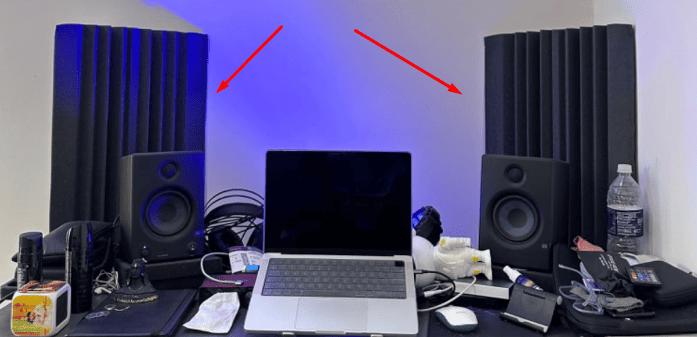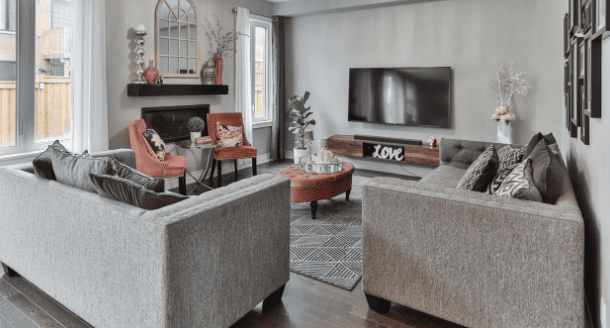This Post may contain affiliate links, when you purchase through links on our site, we may earn an affiliate commission at no extra cost to you. Here’s how it works.
Yes, room acoustics affect stereo sound quality and play a significant role in how audio is perceived. Even with the best stereo sound systems, the sound quality can be compromised if the room acoustics are not controlled.
Table of Contents
ToggleQuick Solutions for Better Stereo Sound
- Use Acoustic Panels & Bass Traps. to absorb reflections.
- Place Speakers Away from Walls.
- Add Soft Furnishings (rugs, curtains) to reduce reflections.
- Treat Reflection Points (walls, ceilings) with diffusers or panels.
- Adjust Room Layout to avoid corners and improve clarity.
How Room Acoustics Affect Stereo Sound Quality
The acoustic properties of a room-such as its size, shape, materials, and furnishings-can influence how sound waves interact within the space. Depending on the room’s acoustics, these sound waves may be reflected, absorbed, or diffused in ways that affect the listening experience.
If don’t know how room acoustics affect Stereo sound quality, Here are several ways that can impact it:
1. Sound Reflection and Echoes
Hard surfaces like walls, windows, and floors can cause sound waves to bounce around the room. These reflections may interfere with the direct sound from the speakers, leading to echoes.
- Solution: To reduce unwanted reflections, you can place acoustic panels on the walls to absorb sound waves and help prevent reflections from reaching your ears. Alternatively, using carpet or rugs on hard floors and adding curtains or furniture can help dampen sound reflections.

2. Bass Buildup and Standing Waves
In a medium or small room, bass tends to accumulate in certain areas, creating areas of excessive bass. This thing is known as standing waves, and especially in square or rectangular rooms it affects more.
- Solution: To address standing waves, you can place bass traps in the room’s corners where low frequencies tend to concentrate. Bass traps are designed to absorb bass energy, reducing the buildup of low-frequency sounds and creating a more balanced sound field.

3. Early Reflections
When sound waves reflect off walls or other surfaces before reaching your ears, they arrive slightly later than the direct sound from the speakers. These early reflections can cause the clarity of the stereo sound quality that you expected.
- Solution: To minimize early reflections, it’s important to carefully place absorptive materials at first reflection points—typically on the sidewalls, the ceiling, and the floor. There are simple methods to locate these reflection points by using a mirror to find where sound from the speakers first bounces.
4. Room Size and Shape
The size and shape of a room directly affect how sound waves behave. In smaller rooms, sound waves may reflect quickly, creating a cluttered or imbalanced sound. Large rooms may cause an overly diffuse soundstage or result in difficult-to-manage acoustics.
- Solution: Room treatment becomes important for both small and large spaces. In smaller rooms, keep the listening position away from the back wall and place speakers away from corners. In larger rooms, a more balanced arrangement of absorptive materials helps prevent the sound from becoming too “distant” or too diffuse.
5. Speaker Placement
The way your stereo speakers are positioned in the room has a huge impact on sound quality. Placing the speakers too close to walls or directly in the corners can amplify certain frequencies or create unwanted reflections.
- Solution: The speakers should form an equilateral triangle with your listening position, and both speakers should be positioned away from walls and corners. For better results, experiment with speaker positions to check what is the perfect placement for those stereo speakers and woofer.
6. Empty Room
Empty rooms are more acoustic than other rooms with sufficient furniture. If you ever visited an empty room, you can hear your voice reflected multiple times, which may be good to listen to but not ideal for the Sound system.
- Solution: Spread furniture throughout the room as much as possible. If you have the budget, you can buy an absorbent pad for your room. You can also add decorative items.
I think now you can understand the issue and probable solution. A room with dozens of furniture and decorative things can easily surpass your room’s acoustic problem. If you want to build your personal theater, you must have to install an acoustic foam panel for better audio quality.
How to Control Room Acoustics for Better Stereo Sound
Even if you don’t have access to a professional acoustic treatment setup, there are several simple steps you can take to improve the acoustics of your room and achieve better stereo sound quality:
1. Room Treatment: Acoustic panels, bass traps, and diffusers commonly treat room acoustics. Acoustic panels absorb high frequencies and early reflections, while bass traps absorb low frequencies.
2. Furniture Arrangement: The placement of furniture in the room can also affect acoustics. Avoid placing speakers directly in corners or against walls. Setup with the listening position at the center of the room can help maintain an even soundstage.

3. Room Size Considerations: If your room is very small or badly shaped, you might experience issues like standing waves or reflections. Consider experimenting with room layout, and speaker placement until you find the best placement that minimizes these acoustic challenges.
4. Portable Acoustic Solutions: For those who may not want to make permanent changes to the room, portable acoustic panels and foam wedges can be a solution. These can be positioned around the room to absorb reflections and improve sound quality.
5. Monitor Position and Angling: When setting up speakers in the room, it is essential to place them at ear level and ensure they are aimed directly at your listening position. Speaker stands are a great option for getting the speakers off the floor and at the proper height.
This are probable treatment if you are facing Room Acoustics after installing a stereo sound system.
Conclusion:
Room acoustics can significantly impact stereo sound quality. Factors such as reflection, absorption, diffusion, and bass response play a crucial role in how audio is perceived in a room. Even the best speakers will not perform at their best in an acoustically imbalanced room.
You can significantly improve the sound quality of your stereo system, by using acoustic treatments such as panels, diffusers, and bass traps, optimizing speaker placement, and fine-tuning your room layout.
